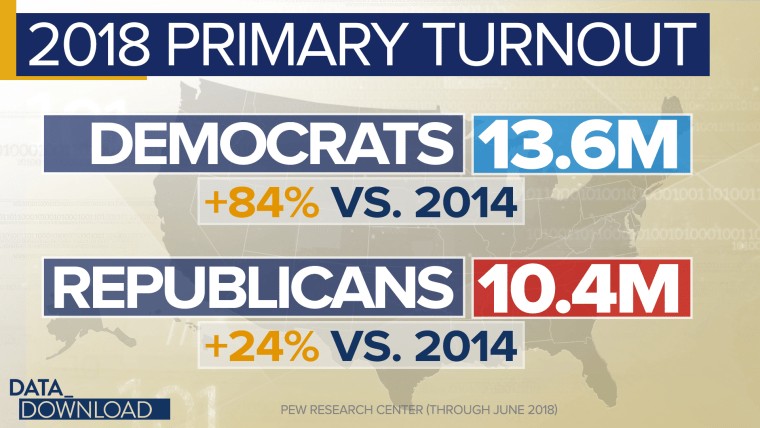Democratic enthusiasm and voter turnout in the 2018 primaries became a dominant narrative, exceeding Republican turnout and raising questions about the implications for the November general election. A Pew Research Center analysis provides a national overview and state-level insights into this surge.
National Democratic Primary Turnout Soared in 2018
Nationally, Democratic House primary turnout saw an impressive 84% increase in 2018 compared to the 2014 midterm elections. Pew reported 13.6 million Democratic voters participated in House primaries, a significant jump from 7.4 million in 2014. While Republican House primary turnout also increased, it did so at a much lower rate of 24%, with 10.7 million votes cast compared to 8.6 million in 2014.
This surge in Democratic primary voters resulted in higher overall Democratic participation in House primaries compared to Republicans in 2018, a reversal of the 2014 trend across the same 31 states. Similar increases were observed in Democratic Senate and gubernatorial primary races.
State-Level Variations in Democratic Primary Turnout
While the national numbers highlight a significant Democratic surge, state-level data reveals a more nuanced picture. Factors such as candidate quality, local issues, and the competitiveness of individual races all contribute to variations in turnout. Key battleground states like California, Ohio, and Iowa illustrate these differences.
California: Significant Democratic Increase, but Republicans Maintain an Edge in Key Districts
California witnessed an 84% increase in Democratic House primary turnout, significantly outpacing the 30% increase for Republicans. This resulted in a substantial Democratic primary vote advantage, nearly 2 million in 2018 compared to roughly 525,000 in 2014.
Despite the surge, Republicans maintained higher overall turnout in most of the state’s competitive congressional districts.
Ohio: Democratic Surge, but Republicans Still Held Overall Turnout Advantage
Ohio also saw increased primary participation for both parties. Democrats experienced a larger increase (67%) compared to Republicans (39%). However, total Republican votes cast still exceeded Democratic votes, 755,000 to 604,000.
While Democrats saw greater increases in several battleground districts, Republican primary turnout remained higher overall in those districts.
Iowa: Dramatic Democratic Surge and Republican Decline
Iowa presented a unique scenario with a substantial Democratic surge (152%) coupled with a significant Republican decline in House primary turnout. This was partly attributed to uncontested Republican races. However, even in uncontested districts, Democratic turnout increased while Republican turnout decreased.
This enthusiasm gap raised concerns for Republicans in several key districts.
Conclusion: Democratic Primary Surge – A Positive Indicator, But November Remains Uncertain
The significant increase in Democratic primary voter turnout in 2018, exceeding that of Republicans, suggested heightened enthusiasm and engagement among Democratic voters. While a positive indicator for Democrats, the ultimate impact on the November general election remained uncertain due to various factors influencing general election outcomes. The state-level data underscores the complexities of interpreting primary results and predicting general election outcomes.
